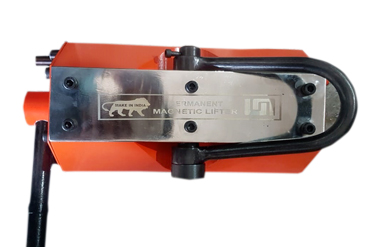
When you’re moving heavy, ferrous loads, you’ll be hard-pressed to find a more convenient tool than a magnetic lifter. That’s because magnetic lifters require no tie-offs or additional manpower. With only the flip of a switch, a small box can carry tons of weight.
How They Work
Most magnetic lifters tend to have slightly different designs, but the general concept is the same. Each magnetic lifter contains a metal cylinder housing powerful neodymium magnets. When turned “off,” these magnets face back into the lifter, and the cylinder and lifter absorb much of the magnetic field. To turn the lifter “on,” the cylinder is turned upside down using a handle. This exposes the magnets to the area underneath the lifter, allowing them to attract heavy objects.
These powerful lifters can carry all sorts of ferromagnetic materials, including heavy metal sheets and beams. Some, like the ones we carry even have a small groove cut underneath to help grab onto metal pipes.
Once the load is in place, the lever can be turned to the “off” position, ending the connection between the lifter and the load.
Safety Practices
When working with magnetic lifters, you want to take the same safety practices you would when working with regular magnets, but with one small addition: You’ll want to add in best practices for working with loads in the air. So in addition to keeping them away from people with pacemakers or defibrillators, everyone in the vicinity should wear hard hats. Of course, you’ll want to keep your hands away from the lifter when it’s “on.”
Special Precautions
Because magnetic lifters are designed to hoist literally tons of weight, they use neodymium magnets. But neodymium magnets are susceptible to damage from heat, so you’ll need to use them in temperature-controlled environments and with materials that aren’t excessively hot. The number to keep in mind: 80c. At this temperature, neodymium magnets begin to decline in strength. If they’re kept at this temperature, they’ll permanently lose their magnetism.
Magnetic lifters — and the materials they lift — should be kept clear of debris. When the lifter is in use, huge amounts of force pull the lifter and the ferromagnetic material together. Anything in between can be crushed, cut into the lifter or the material, or even burst and kick out into the open, creating a safety hazard.
Finally, you’ll want to take note of the stats on each lifter. Each magnetic lifter has three important numbers:
The rated capacity- The maximum working weight for non-cylindrical objects, like steel I-beams or sheets of metal.
The cylindrical capacity- The maximum working weight for cylindrical objects, like pipes. Because cylinders offer less surface area for a lifter to grab, the cylindrical capacity is typically ⅔ of the regular capacity.
The max tear-off strength- The total weight required to pull an attached item away from the lifter. This is typically 3.5 times the rated capacity. For example: If a lifter is rated at 100kg, the max-tear would be 350kg. If the lifter was already holding 100kg, and three people jumped onto the load to add an extra 251kg, there would be enough weight to detach from the lifter.
When your facility needs a magnetic lifter, call on Un Engineering Works. We have three lifters of varying strengths, so you’ll be sure to find one to fit your needs. If you don’t see what you’re looking for, contact us for additional options







